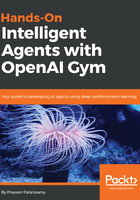
Learning environments
A learning environment is an integral component of a system where an intelligent agent can be trained to develop intelligent systems. The learning environment defines the problem or the task for the agent to complete.
A problem or task in which the outcome depends on a sequence of decisions made or actions taken is a sequential decision-making problem. Here are some of the varieties of learning environments:
- Fully observable versus partially observable
- Deterministic versus stochastic
- Episodic versus sequential
- Static versus dynamic
- Discrete versus continuous
- Discrete state space versus continuous state space
- Discrete action space versus continuous action space
In this book, we will be using learning environments implemented using the OpenAI Gym Python library, as it provides a simple and standard interface and environment implementations, along with the ability to implement new custom environments.
In the following subsections, we will get a glimpse of the OpenAI Gym toolkit. This section is geared towards familiarizing a complete newbie with the OpenAI Gym toolkit. No prior knowledge or experience is assumed. We will first try to get a feel for the Gym toolkit and walk through the various environments that are available under different categories. We will then discuss the features of Gym that might be of interest to you, irrespective of the application domain that you are interested in. We'll then briefly discuss what the value proposition of the Gym toolkit is and how you can utilize it. We will be building several cool and intelligent agents in subsequent chapters, building on top of the Gym toolkit. So, this chapter is really the foundation for all that. We will also be quickly creating and visualizing our first OpenAI Gym environment towards the end of this chapter. Excited? Let's jump right in.